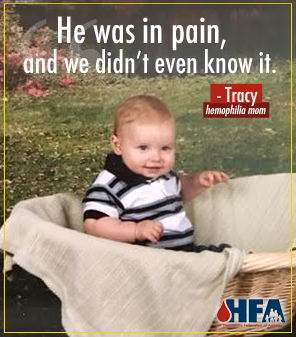
I was cleaning out my closet recently and found an old picture of Nick stuffed in the pocket of a purse. My first thought was, “Man, he was a cute baby.” My second thought was, “That was right before he had a spontaneous epidural bleed.”
Nick was eleven months old, in daycare, and not walking yet. So many parents are so anxious for their babies to take those first steps, and worry that they’re delayed if they haven’t by some certain time. Not me! I was totally fine with him waiting to walk as long as he wanted. By this point in his infancy, Nick had endured several spontaneous joint and soft tissue bleeds. At the same time, he had experienced several ear infections and was on an antibiotic that regularly upset his stomach. He hadn’t been acting like himself for several days. I was in touch with the pediatrician’s office and we kept chalking his fussiness up to gas. Looking back, I can see several warning signs that should have triggered me to push for more answers, but I was still new at this hemophilia thing and hindsight is always 20/20. Despite being a generally happy baby, Nick had been fussy for several days and would cry when I laid him on his back to change his diaper. Another red flag, but I was still going with gas. His fussiness continued to increase until we had two nights in a row that my husband and I took turns walking the halls with him. I couldn’t lay him down; I couldn’t sit down with him. Nothing would settle him except laps around the house. As a result of sheer exhaustion, but I finally called our HTC nurse and said, “I don’t think it’s anything, but…” We went through a series of questions, to which I answered “no” to all, until she asked what his reaction was if I held him up as if to stand on the floor. Did he straighten his legs out? Lots of red flags waving now! He wouldn’t straighten his legs out but rather pulled them up into a frog like position. Her response was “Bring him in as soon as you can.” I wanted to say, “Wait – he just has gas!”
Despite being a generally happy baby, Nick had been fussy for several days and would cry when I laid him on his back to change his diaper. Another red flag, but I was still going with gas. His fussiness continued to increase until we had two nights in a row that my husband and I took turns walking the halls with him. I couldn’t lay him down; I couldn’t sit down with him. Nothing would settle him except laps around the house. As a result of sheer exhaustion, but I finally called our HTC nurse and said, “I don’t think it’s anything, but…” We went through a series of questions, to which I answered “no” to all, until she asked what his reaction was if I held him up as if to stand on the floor. Did he straighten his legs out? Lots of red flags waving now! He wouldn’t straighten his legs out but rather pulled them up into a frog like position. Her response was “Bring him in as soon as you can.” I wanted to say, “Wait – he just has gas!”
After a few scans, the doctor called us in to tell us that the epidural area of Nick’s spine was filled with blood. We sure never saw that coming! This led to two days in the Pediatric Intensive Care Unit (PICU), a TON of factor, and port surgery so we could start prophylaxis. Five weeks later, we went home and Nick was on three days a week treatment with a nurse coming to our house.
Nick had an infection in his first port, and he received his second port on his first birthday. He had surgery in the morning and birthday cake in the afternoon. In my mind, I can still see him sitting in a high chair, with a hospital gown on and a birthday hat on his head eating chocolate cake. I couldn’t tell you what I ate for lunch yesterday, but I can remember every detail of that picture.
If your child has port surgery in the near future or know that it is a real possibility, know that I LOVED that port. We were able to start prophylaxis which helped tremendously in breaking the cycle of his once a month bleeds. We had an amazing home health nurse that knew exactly when to gently nudge me into learning to infuse him which led to independence. It was truly a gift.
I so badly want to look at these pictures and chuckle about what a fat baby he was, show him how cute he was, remember buying that shirt for his “school” pictures, etc, but instead, I look at the pictures and shed a few tears remembering what pain he must have been in and we had no idea. Who knew one picture could tell such a story.
Tracy, her husband, Lance, and son, Nick, (13-years-old) live in Virginia.
___________________________________________
*Note: “Infusing Love: A Mom’s View,” is a blog collection of personal opinions and a representation of individuals experiences. While extensive efforts are made to ensure accuracy of the content, the blog entries do not represent HFA or its Board of Directors. The blog is also not intended to be construed as medical advice or the official opinion/position of HFA, its staff, or its Board of Directors. Readers are strongly encouraged to discuss their own medical treatment with their healthcare providers.Â



